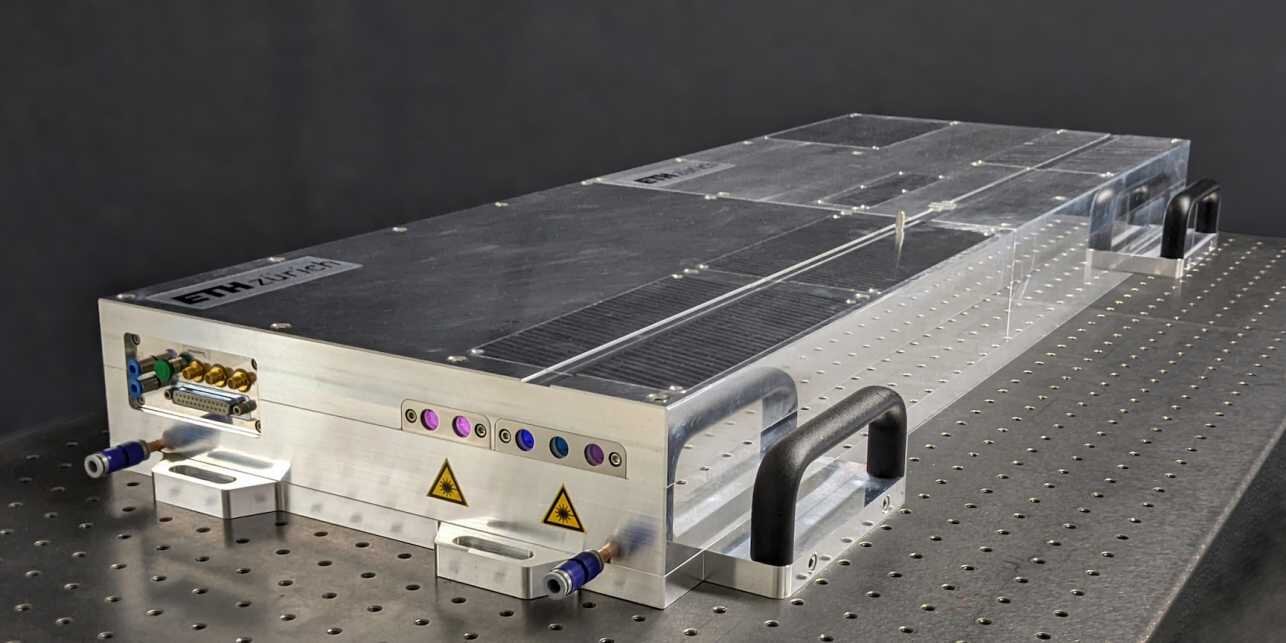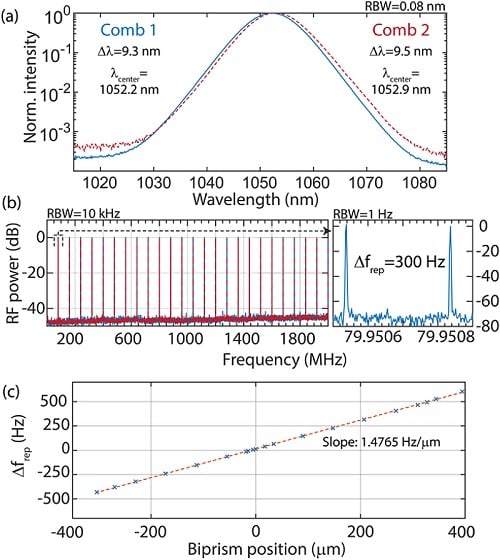Various applications of pulsed laser sources rely on the ability to produce a series of pulse pairs with a stepwise increasing delay between them. Implementing such optical delay scanning with high precision is demanding, particularly for long delays.
To address this challenge, physicists from ETH Zurich have developed a versatile “dual-comb” laser that combines a wide scanning range with high power, low noise, stable operation, and ease of use — thereby opening possibilities for practical uses.
The obtained performance — including the high power of more than 2.4 W for each comb; the short pulse durations of less than 140 fs; and the demonstrated coupling to an optical parametric oscillator for converting the light into a different wavelength regime — underline the practical potential of the approach for a wide spectrum of measurements, from precision optical ranging to high-resolution absorption spectroscopy and nonlinear spectroscopy for sampling ultrafast phenomena.
Ultrafast laser technology has enabled a trove of methods for precision measurements. These include in particular a broad class of pulsed-laser experiments in which a sample is excited, and, after a variable amount of time, the response is measured. In such studies, the delay between the two pulses should typically cover the range from femtoseconds to nanoseconds.

The compact single-cavity dual-comb laser system developed by ETH Zurich researchers. The device combines a wide scanning range with high power, low noise, stable operation, and ease of use, supporting multiple applications in spectroscopy and precision measurements. Courtesy of ETH Zurich/D-PHYS Benjamin Willenberg.
In practice, scanning the delay time over a range that broad in a repeatable and precise manner poses a significant challenge. The conceptually simplest solution to scanning optical delays is based on a laser whose output is split into two pulses. While one pulse takes a fixed route to the target, the optical path for the second pulse is varied with linearly displacing mirrors. The longer the path between mirrors, the later the laser pulse arrives at the target and the longer the delay relative to the first pulse.
The problem, however, is that light travels at a famously high speed, covering some 0.3 m/ns in air. For mechanical delay lines, this means that scanning to delays up to several nanoseconds requires large devices with intricate and typically slow mechanical construction.
A way to avoid these complex constructions is to use a pair of ultrashort pulse lasers that emit trains of pulses, each at slightly different repetition rates. If, for example, the first pulses emerging from each of the lasers are perfectly synchronized, then the second pair has a delay between the pulses that corresponds to the difference in repetition times of the two lasers.
The next pair of pulses has twice that delay between them, and so on. In this manner, a perfectly linear and fast scan of optical delays without moving parts is possible in theory. The most refined type of laser system generating two such pulse trains is known as a dual comb, in reference to the spectral structure of the output consisting of a pair of optical frequency combs.
Though the promise of the dual-comb approach has long been clear, progress toward applications was hindered by challenges related to designing a readily deployable laser system that provides two simultaneously operating combs of the required quality and with high relative stability.

(a) Laser output spectrum in log scale measured with an optical spectrum analyzer. (b) Normalized power spectral density of the photocurrent generated from a fast photodiode, analyzed with a microwave spectrum analyzer. Inset shows zoom on the first harmonic of the two radio-frequency combs. (c) Repetition rate difference versus the biprism lateral position using a picomotor (Newport). Courtesy of Optica (2022). DOI: 10.1364/OPTICA.457787.
The key, the ETH Zurich team found, is to generate the two frequency combs in a single laser cavity. The researchers constructed a laser source consisting of two coherent optical pulse trains that are basically identical in all properties except repetition rate. Previous approaches for realizing laser-cavity multiplexing have been introduced in the past, though they typically require additional components to be placed within the cavity, introducing losses and changes in dispersion characteristics for the two combs, among other issues.
To overcome these issues, the team inserted a “biprism” into the cavity. The team’s device had two separate angles on the surface from which light is reflected. The biprism split the cavity mode into two parts, and the researchers showed that by suitable design of the optical cavity, the two combs could be spatially separated on the active intracavity components while still taking a very similar path otherwise.
In the context of the design, “active components” refers to the gain medium, and to the so-called semiconductor saturable absorber mirror (SESAM) element, which enables mode-locking and pulse generation. The spatial separation of the modes at these stages means that two combs with distinct spacing can be generated, while most other properties are essentially duplicated. Particularly, the two combs have highly correlated timing noise. While imperfections in the temporal comb structure are unavoidably present, the difference is small enough to allow the resulting noise to be dealt with.
One of the most attractive features of the novel single-cavity architecture is that it doesn’t require compromises in laser design. Instead, cavity architectures that are optimal for single-comb operation can be readily adapted for dual comb use. With this, the new design also represents a major simplification relative to commercial products and opens a path for the production and deployment of this new class of ultrafast laser sources.
First demonstrations yielded promising results. The researchers scanned an optical delay of 12.5 ns, which is equivalent to distance of 3.75 m in air, with 2-fs precision, which is less than a micron in physical distance, at rates up to 500 Hz. Further, according to the researchers, the demonstration achieved record-high stability for a single-cavity dual-comb laser.
The research was published in Optica (www.doi.org/10.1364/OPTICA.457787).